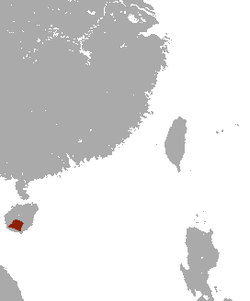| Hainan gymnure | |
|---|---|
 | |
| Scientific classification | |
| Kingdom: | Animalia |
| Phylum: | Chordata |
| Class: | Mammalia |
| Order: | Eulipotyphla |
| Family: | Erinaceidae |
| Subfamily: | Galericinae |
| Genus: | Neohylomys Shaw and Wong, 1959 |
| Species: | N. hainanensis |
| Binomial name | |
| Neohylomys hainanensis Shaw & Wong, 1959 | |
 | |
| Hainan gymnure range | |
The Hainan gymnure (Neohylomys hainanensis), also known as the Hainan moonrat, is a species of mammal in the family Erinaceidae. Its natural habitat is subtropical or tropical dry forests. It was thought to be endemic to the island of Hainan, China, where it is threatened due to habitat loss, but in 2018 was found to also occur in, and be rather common, in Northern Vietnam. [2]
Contents
The Hainan gymnure is the only species in the monotypic genus Neohylomys. Although previously considered part of the genus Hylomys , gene sequencing of a mitochondrial cytochrome b gene provided evidence that the species is sufficiently distantly related to comprise a genus of its own. [3]
